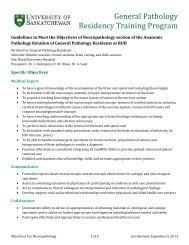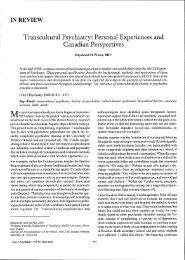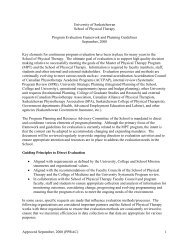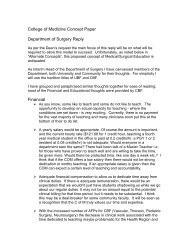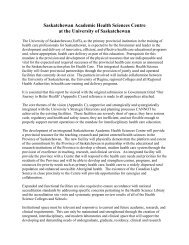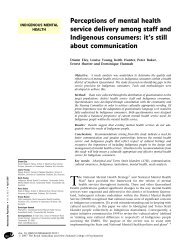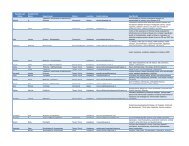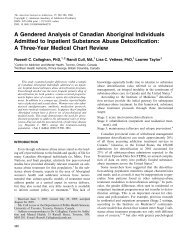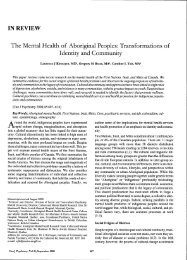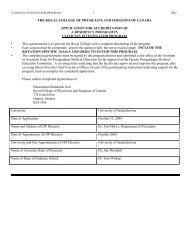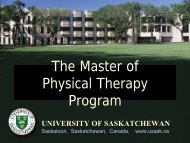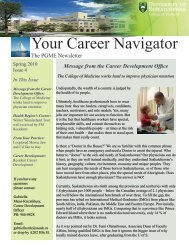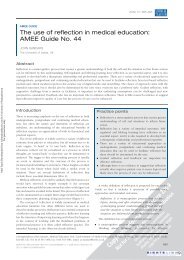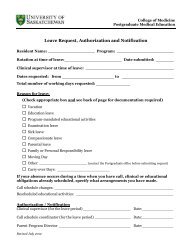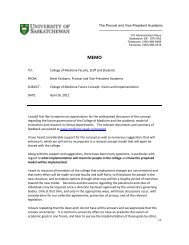Shaping Our Medical Education Journey - College of Medicine ...
Shaping Our Medical Education Journey - College of Medicine ...
Shaping Our Medical Education Journey - College of Medicine ...
You also want an ePaper? Increase the reach of your titles
YUMPU automatically turns print PDFs into web optimized ePapers that Google loves.
COMMUNIQUé<br />
<strong>College</strong> <strong>of</strong> <strong>Medicine</strong> magazine<br />
SPRING 2011<br />
<strong>Shaping</strong> our<br />
<strong>Medical</strong> <strong>Education</strong><br />
<strong>Journey</strong><br />
University <strong>of</strong> Saskatchewan • <strong>College</strong> <strong>of</strong> <strong>Medicine</strong> C O M M U N I Q U É 1
Table <strong>of</strong> Contents<br />
Dean’s Message – <strong>Our</strong> <strong>Medical</strong> <strong>Education</strong> <strong>Journey</strong><br />
The Difference a Bursary Makes / The Difference<br />
1<br />
a Donor Makes 2<br />
A Prescription for Change – The Future<br />
<strong>of</strong> <strong>Medical</strong> <strong>Education</strong> in Canada 4<br />
SMSS Student Corner 6<br />
News from PAIRS 8<br />
<strong>Our</strong> Winning Team – School <strong>of</strong> Physical Therapy 9<br />
<strong>College</strong> Awards and Honours 10<br />
Preparing for the Future Today – Third Integrated Plan 12<br />
The Physician Recruitment Agency <strong>of</strong> Saskatchewan 14<br />
Making a Difference – Saskatchewan Health<br />
Research with Impact – Research 16<br />
Health Training in French / Formation Santé<br />
en Francais – Social Accountability 18<br />
<strong>Our</strong> Collective Wellbeing 20<br />
Living Well – Physician Wellness Initiative 20<br />
Building the Foundation for Health Sciences<br />
<strong>Education</strong> and Research 22<br />
PRAS Rural Externship Program 24<br />
s Physical Therapy<br />
<strong>Our</strong> Winning<br />
Team<br />
9<br />
2<br />
s<br />
Donor Relations<br />
The Difference a<br />
Bursary/Donor Makes<br />
s FMEC<br />
A Prescription for Change<br />
24<br />
C O M M U N I Q U É <strong>College</strong> <strong>of</strong> <strong>Medicine</strong> • University <strong>of</strong> Saskatchewan<br />
4<br />
s PRAS Rural Externship Program<br />
Externships Fuelling Interest<br />
in Rural Family <strong>Medicine</strong><br />
LeadershIp TeaM<br />
Dean <strong>of</strong> <strong>Medicine</strong>: Dr. William Albritton<br />
SPRING 2011<br />
Associate Dean, Biomedical Sciences and Graduate Studies: Dr. Nick Ovsenek<br />
Associate Dean, Faculty Affairs: Dr. Olufemi Olatunbosun<br />
Associate Dean, <strong>Medical</strong> <strong>Education</strong>: Dr. Shelia Harding (on leave)<br />
Associate Dean, Physical Therapy and Rehabilitation Sciences: Dr. Liz Harrison (on leave)<br />
Associate Dean, Regina Programs: Dr. Gill White<br />
Associate Dean, Research: Dr. Lou Qualtiere<br />
Associate Dean, Rural and Northern <strong>Medical</strong> Programs: Dr. Tom Smith-Windsor<br />
Associate Dean, Saskatoon Programs: Dr. Grant Stoneham<br />
Assistant Dean, Continuing Pr<strong>of</strong>essional Learning: Dr. Penny Davis<br />
Assistant Dean, Postgraduate <strong>Medical</strong> <strong>Education</strong>: Dr. Anurag Saxena<br />
Assistant Dean, Undergraduate <strong>Medical</strong> <strong>Education</strong>: Dr. Gary Linassi<br />
Director, Admissions: Dr. Barry Ziola<br />
Director, <strong>Education</strong>al Support and Development: Dr. Marcel D’Eon<br />
Director, Student Affairs: Dr. Susan Gilmer (acting)<br />
Chief Financial Officer and Director <strong>of</strong> Administration: Ms. Ann Schultz<br />
Manager, Human Resources: Mr.Bill Ng (acting)<br />
deparTMeNT heads<br />
Anatomy and Cell Biology: Dr. Ric Devon<br />
Anesthesia, Perioperative <strong>Medicine</strong> and Pain Management: Dr. David Campbell<br />
Biochemistry: Dr. Ramji Khandelwal<br />
Community Health and Epidemiology: Dr. Nazeem Muhajarine<br />
Family <strong>Medicine</strong>: Dr. Alanna Danilkewich (acting)<br />
<strong>Medical</strong> Imaging: Dr. Paul Babyn<br />
<strong>Medicine</strong>: Dr. Vernon Hoeppner<br />
Microbiology and Immunology: Dr. Peter Bretscher<br />
Obstetrics, Gynecology and Reproductive Sciences: Dr. Tom Mainprize<br />
Pathology and Laboratory <strong>Medicine</strong>: Dr. John Krahn<br />
Pediatrics: Dr. Bill Bingham<br />
Pharmacology: Dr. Venkat Gopalakrishnan<br />
Physical <strong>Medicine</strong> and Rehabilitation: Dr. Lila Rudachyk<br />
Physiology: Dr. Michel Desautels<br />
Psychiatry: Dr. Marilyn Baetz<br />
School <strong>of</strong> Physical Therapy: Dr. Angela Busch<br />
Surgery: Dr. William Dust (acting)<br />
advaNCeMeNT TeaM<br />
Alumni Relations: Ms. Verity Moore-Wright<br />
Communications: Ms. Laura Herman<br />
Development: Mr. Fred J. Matiko<br />
Donor Relations: Ms. Emily Bocking<br />
Support: Ms. Christine Wood<br />
Design: Ms. Deanna Miller<br />
COMMUNIQUé <strong>College</strong> <strong>of</strong> <strong>Medicine</strong> magazine<br />
Published by the <strong>College</strong> <strong>of</strong> <strong>Medicine</strong>, University <strong>of</strong> Saskatchewan.<br />
For regular updates, please visit www. medicine.usask.ca
<strong>Medical</strong> education, and everything surrounding<br />
and supporting it, is a journey.<br />
“ ”<br />
Dean’s<br />
Message<br />
OUR MEDICAl EDUCATION JOURNEy<br />
Colleagues, Alumni, Friends and Students<br />
On June 1, members <strong>of</strong> our <strong>College</strong> <strong>of</strong> <strong>Medicine</strong> Class <strong>of</strong> 2011 will take<br />
the final step in their undergraduate medical education careers. The<br />
moment they have been striving towards will finally arrive. For the<br />
first time, they will be called doctor.<br />
As we celebrate their accomplishments during the Convocation<br />
Ceremony and Graduation Banquet, we are reminded <strong>of</strong> the<br />
significance <strong>of</strong> this milestone in their academic and pr<strong>of</strong>essional<br />
careers. For most, the journey will continue with residency. In fact,<br />
42 members <strong>of</strong> this graduating class will train right here at home in<br />
Saskatchewan. Even if postgraduate training is not an immediate<br />
consideration, each new alumnus <strong>of</strong> our <strong>College</strong> <strong>of</strong> <strong>Medicine</strong> will<br />
continue as a student <strong>of</strong> life, and we wish them the very best in their<br />
personal journeys.<br />
<strong>Our</strong> <strong>College</strong> <strong>of</strong> <strong>Medicine</strong> is also on a journey, one which is multifaceted,<br />
and really, quite fascinating to watch unfold. We’ve grown<br />
significantly, in faculty, in teaching, in research, and in complexity<br />
since the inception <strong>of</strong> the four-year program in 1954. From a class-size<br />
<strong>of</strong> 33 – 40 in the mid-50s, to a planned expansion to 100 first-year<br />
students beginning in the fall <strong>of</strong> 2012, we are truly increasing our<br />
potential to serve the needs <strong>of</strong> Saskatchewan and beyond.<br />
This is critically important, because our founding vision mandated<br />
our <strong>College</strong> as a provincial resource. Having 100 students in each<br />
year <strong>of</strong> our undergraduate program provides us with the critical mass<br />
necessary to fully adopt and implement our own model <strong>of</strong> distributed<br />
medical education. In keeping with Government <strong>of</strong> Saskatchewan<br />
directives, and in collaboration with the University <strong>of</strong> Saskatchewan<br />
and the Saskatchewan Academic Health Sciences Network, the<br />
<strong>College</strong> <strong>of</strong> <strong>Medicine</strong> believes this approach will serve to improve the<br />
student educational experience and enhance access to healthcare.<br />
Simply put, these are exciting times <strong>of</strong> expansion for your <strong>College</strong> <strong>of</strong><br />
<strong>Medicine</strong>. In fact, we received 833 applications for this fall’s first-year<br />
class. 323 were invited to participate in the Multiple-Mini Interview<br />
weekend as part <strong>of</strong> the admissions process. 84 <strong>of</strong> these students will<br />
ultimately form our incoming class this fall.<br />
Without a roadmap and a plan, this journey would leave us lost.<br />
<strong>Our</strong> roadmap is the Association <strong>of</strong> Faculties <strong>of</strong> <strong>Medicine</strong> <strong>of</strong> Canada<br />
(AFMC) Report entitled The Future <strong>of</strong> <strong>Medical</strong> <strong>Education</strong> in Canada.<br />
A progress report on this important work can be found on page 4.<br />
<strong>Our</strong> plan will be the <strong>College</strong> <strong>of</strong> <strong>Medicine</strong>’s third integrated plan, or<br />
IP3, developed under the University’s Integrated Planning umbrella.<br />
The goal is for the <strong>College</strong> to align our academic priorities with<br />
our financial resources and to ensure the work <strong>of</strong> our <strong>College</strong> is<br />
consistent with the University’s overall strategic directions. Details<br />
and information on how you can engage in this critical process are<br />
outlined on page 12.<br />
Finally, with respect to our educational journey, I mentioned in<br />
my last message our <strong>College</strong> was preparing for a secretariat factfinding<br />
visit. The Committee on the Accreditation <strong>of</strong> Canadian<br />
<strong>Medical</strong> Schools (CACMS) and its American counterpart, the Liaison<br />
Committee on <strong>Medical</strong> <strong>Education</strong> (LCME) visited with us in Saskatoon<br />
and Regina over three days, early in March. The <strong>College</strong> will receive<br />
a formal report on the secretariat’s findings later this year, but<br />
early indications received through the exit interview suggest that,<br />
although we continue to show weaknesses in certain areas, we<br />
are poised for continued success. Dr. Gary Linassi, Assistant Dean,<br />
<strong>Medical</strong> <strong>Education</strong>, and the entire UGME team deserve our collective<br />
praise, admiration and appreciation for their ongoing work<br />
in this regard.<br />
<strong>Medical</strong> education, and everything surrounding and supporting it, is<br />
a journey. It is road that will wind, have bumps, will twist and turn. By<br />
using the tools we have been given to improve our programs, we are<br />
enabling our collective journey.<br />
It is a time to celebrate accomplishments and look forward to the<br />
road which lies ahead.<br />
Sincerely,<br />
William Albritton<br />
Dean, <strong>College</strong> <strong>of</strong> <strong>Medicine</strong><br />
University <strong>of</strong> Saskatchewan<br />
University <strong>of</strong> Saskatchewan • <strong>College</strong> <strong>of</strong> <strong>Medicine</strong> C O M M U N I Q U É 1
The Difference a<br />
Bursary Makes<br />
Jon Starr is on his way to becoming a<br />
doctor so he can help people and provide<br />
for his young family. Thanks in large part to<br />
the William and Diana Kindrachuk Bursary,<br />
John’s ambitions aren’t being held back by<br />
his bank account. His dreams are becoming<br />
a reality.<br />
Jon was working on the prerequisites for<br />
admissions to medical school. In 2006, Jon’s<br />
son Jared was born. In an elevator at Royal<br />
University Hospital on the way up to visit<br />
his new baby, Jon realized he truly wanted<br />
to pursue his dream <strong>of</strong> becoming a<br />
doctor. “I knew that in order to give my<br />
family everything that I wanted them to<br />
have, I would have to be something more.”<br />
Jon passed his CoM entrance exams,<br />
“<br />
I knew that<br />
in order to<br />
give my family<br />
everything<br />
that I wanted<br />
them to have, I<br />
would have to<br />
be something<br />
more.”<br />
”<br />
2 C O M M U N I Q U É <strong>College</strong> <strong>of</strong> <strong>Medicine</strong> • University <strong>of</strong> Saskatchewan<br />
but the reality <strong>of</strong> paying for a medical<br />
education while also balancing the<br />
financial responsibilities accompanying<br />
a young family proved to be problematic.<br />
“I had planned how I was going to pay for<br />
my education, but I couldn’t get a line <strong>of</strong><br />
credit. My parents tried to help me, but<br />
they are already helping my sister and her<br />
family. It worked out because I managed<br />
to get a loan and I planned on playing in<br />
a paid hockey league to earn some extra<br />
money. It was really, really stressful.”<br />
Some <strong>of</strong> the stress washed away instantly<br />
for Jon and his family in January 2011<br />
when he was awarded the William and<br />
Diana Kindrachuk bursary for Aboriginal<br />
Jon Starr and family<br />
Students in the <strong>College</strong> <strong>of</strong> <strong>Medicine</strong>. The<br />
bursary covers the tuition <strong>of</strong> one Aboriginal<br />
medical student and is renewable for Jon’s<br />
entire four-year program.<br />
“Winning this award took a load <strong>of</strong>f <strong>of</strong><br />
mine and my parents minds. The fact that<br />
it is renewable means that I can really<br />
study and get involved in mentoring<br />
other aboriginal students in the <strong>College</strong><br />
<strong>of</strong> <strong>Medicine</strong>.”<br />
Jon’s fiancée Char is currently enrolled in<br />
the Post degree concentrated bachelor<br />
<strong>of</strong> nursing program at the University <strong>of</strong><br />
Saskatchewan.<br />
On behalf <strong>of</strong> the <strong>College</strong> <strong>of</strong> <strong>Medicine</strong>, we wish Jon and his family all the best in their<br />
academic and personal pursuits<br />
s
The Difference a<br />
Donor Makes<br />
Dr. William Kindrachuk, U <strong>of</strong> S <strong>College</strong> <strong>of</strong> <strong>Medicine</strong><br />
Class <strong>of</strong> 1953<br />
Dr. William Kindrachuk, U <strong>of</strong> S <strong>College</strong> <strong>of</strong><br />
<strong>Medicine</strong> Class <strong>of</strong> 1953, made a $93,000 gift<br />
to the University <strong>of</strong> Saskatchewan in 2007.<br />
Half <strong>of</strong> his very generous donation was<br />
allocated to children <strong>of</strong> employees<br />
<strong>of</strong> the Lakeview Pioneer Lodge elder home<br />
in Wakaw, with the other half directed to<br />
establish the William and Diana Kindrachuk<br />
Bursaries in <strong>Medicine</strong> for Aboriginal<br />
students in the <strong>College</strong> <strong>of</strong> <strong>Medicine</strong>.<br />
Dr. Kindrachuk grew up on a farm near Fish<br />
Creek which was originally homesteaded<br />
by his grandfather in 1900. The 1930s and<br />
40s were spent on the farm, where he<br />
first became acquainted with the adverse<br />
living conditions Aboriginal peoples <strong>of</strong>ten<br />
faced. “<strong>Our</strong> house was about 4 km from<br />
the One Arrow reserve, and although my<br />
family didn’t have a close relationship with<br />
members <strong>of</strong> the aboriginal community, we<br />
definitely interacted with them and were<br />
aware <strong>of</strong> the challenges they faced in<br />
trying to make a living.”<br />
Like many farm kids, the young Kindrachuk<br />
took correspondence school for grades 9-11<br />
and transferred to Bedford Road Collegiate<br />
in 1945 to complete Grade 12. At 16, he<br />
took a full time job at the Hudson’s Bay<br />
Company, earning $21.40 a week and saving<br />
for his first year <strong>of</strong> university tuition. He<br />
was able to work and pay his way through<br />
school by painting grain elevators in Alberta<br />
with other University <strong>of</strong> Saskatchewan<br />
students. “It cost us about $12 dollars each<br />
to get to Calgary<br />
by train. There<br />
were about 10<br />
<strong>of</strong> us – all in<br />
medical school<br />
or working<br />
as Ph.D.<br />
candidates.<br />
We’d work all<br />
summer – it<br />
was a dirty job,<br />
but it paid<br />
our tuition.”<br />
Funding his last<br />
two years <strong>of</strong><br />
medical school<br />
proved difficult.<br />
There simply<br />
was not enough<br />
time between academic sessions to earn<br />
sufficient money. A loan to finance the<br />
balance was his only option.<br />
Dr. Kindrachuk moved on to practice<br />
medicine in Glen Ellyn, Illinois, but his<br />
early experiences in Saskatchewan stuck<br />
with him. “The University <strong>of</strong> Saskatchewan<br />
provided me with my start at a very<br />
reasonable cost, and I wanted to share<br />
my good fortune. I created the fund<br />
to assist aboriginal medical students<br />
because I thought these students needed<br />
help and I wasn’t aware <strong>of</strong> any programs<br />
providing them with an adequate<br />
amount <strong>of</strong> support. Dr. Kindrachuk’s gift<br />
was motivated by his personal belief in<br />
“sharing his good fortune.”<br />
The Kindrachuk family’s commitment to<br />
medicine remains strong: Dr. Kindrachuk<br />
and two <strong>of</strong> his brothers became doctors,<br />
and many <strong>of</strong> their children decided to<br />
continue the family legacy.<br />
Saskatchewan is still an important part<br />
<strong>of</strong> Dr. Kindrachuk’s life, and his love<br />
for this place continues to be shared<br />
with his family. In fact, five <strong>of</strong> his nine<br />
grandchildren have visited the province.<br />
“<br />
The University<br />
<strong>of</strong> Saskatchewan<br />
provided me with<br />
my start and I<br />
wanted to share<br />
my good fortune.<br />
”<br />
Students from Saskatchewan are<br />
reminded <strong>of</strong> Dr. Kindrachuk’s generosity<br />
frequently, especially those who have<br />
parents on staff at the senior’s home<br />
near Wakaw. Dr. Kindrachuk’s mother<br />
was a resident in the home for over two<br />
decades, until she passed away at the<br />
age <strong>of</strong> 95. Half <strong>of</strong> Dr. Kindrachuk’s gift<br />
to the U <strong>of</strong> S was used to establish<br />
a bursary for the children <strong>of</strong> his<br />
mother’s caregivers.<br />
On behalf <strong>of</strong> the <strong>College</strong> <strong>of</strong> <strong>Medicine</strong>,<br />
we wish to thank Dr. Kindrachuk for his<br />
support and commitment to effecting<br />
change in our students’ lives. n<br />
University <strong>of</strong> Saskatchewan • <strong>College</strong> <strong>of</strong> <strong>Medicine</strong> C O M M U N I Q U É 3
A Prescription<br />
for Change<br />
Implementing the FMEC Report at<br />
the <strong>College</strong> <strong>of</strong> <strong>Medicine</strong><br />
The University <strong>of</strong> Saskatchewan <strong>College</strong> <strong>of</strong><br />
<strong>Medicine</strong> is committed to enhancing MD<br />
education to ensure today’s learners are<br />
well-prepared for the challenges <strong>of</strong> the future.<br />
“Implementing the recommendations contained<br />
in The Future <strong>of</strong> <strong>Medical</strong> <strong>Education</strong> in Canada<br />
(FMEC): A Collective Vision for MD <strong>Education</strong> will<br />
help us to meet the evolving needs <strong>of</strong> individuals<br />
and communities in Saskatchewan,” said<br />
Dr. William Albritton, Dean <strong>of</strong> the <strong>College</strong> <strong>of</strong><br />
<strong>Medicine</strong>. “Examining the FMEC recommendations<br />
and discussing how to embed them within<br />
the undergraduate curriculum is a high<br />
priority for our <strong>College</strong>.”<br />
The Association <strong>of</strong> Faculties <strong>of</strong> <strong>Medicine</strong> <strong>of</strong> Canada (AFMC)<br />
released the FMEC report in January 2010, following a Health<br />
Canada-funded study <strong>of</strong> undergraduate medical education.<br />
According to the AFMC, which represents Canada’s 17 faculties<br />
<strong>of</strong> medicine, the 30-month FMEC project “set out to conduct a<br />
thorough review <strong>of</strong> medical doctor (MD) education in Canada,<br />
assess current and future societal needs, and identify the changes<br />
needed to better align the two.” This resulted in the national<br />
launch <strong>of</strong> the FMEC report, which contains 10 recommendations<br />
and five enabling recommendations that comprise the FMEC<br />
Collective Vision.<br />
At the <strong>College</strong>, each recommendation is being championed<br />
by a leader. Each leader is responsible for forming a working<br />
group that will discuss how the recommendation’s objectives<br />
can be achieved. The <strong>College</strong> has also hired an FMEC project<br />
coordinator, who will assist the working groups in the examination<br />
<strong>of</strong> the recommendations and who will write the <strong>College</strong>’s FMEC<br />
implementation report. The report will be complete in fall 2011.<br />
“As we enter our own period <strong>of</strong> curriculum renewal, the U <strong>of</strong> S<br />
undergraduate medical program is well poised to engage in this<br />
For more information on the FMEC project, visit the <strong>College</strong> <strong>of</strong> <strong>Medicine</strong>’s website at http://www.medicine.usask.ca/leadership/fmec.html<br />
or the AFMC’s FMEC website at http://www.afmc.ca/future-<strong>of</strong>-medical-education-in-canada/.<br />
4 C O M M U N I Q U É <strong>College</strong> <strong>of</strong> <strong>Medicine</strong> • University <strong>of</strong> Saskatchewan<br />
comprehensive review <strong>of</strong> medical education,” said Dr. Gary Linassi,<br />
Assistant Dean, Undergraduate <strong>Medical</strong> <strong>Education</strong>.<br />
“It is vitally important<br />
that we align our training<br />
priorities beyond the<br />
‘medical expert’ role to<br />
meet society’s changing<br />
needs and increasing<br />
expectations <strong>of</strong> the medical<br />
practitioner,” said Dr.<br />
Linassi, who is leading<br />
the FMEC working group<br />
responsible for examining<br />
Recommendation IX:<br />
Adopt a Competency-<br />
Based and Flexible<br />
Approach. “The FMEC<br />
visionary statement<br />
identifies key expanded<br />
s
oles and guides medical education in their development<br />
to ensure inclusion in undergraduate medical curricula<br />
across Canada.”<br />
“The U <strong>of</strong> S <strong>College</strong> <strong>of</strong> <strong>Medicine</strong> has embraced the FMEC<br />
recommendations, which will enhance work that is currently<br />
A working group leader has been assigned to each FMEC Recommendation.<br />
The ten Recommendations and the leaders are as follows:<br />
underway in our <strong>College</strong>,” added Dr. Albritton, who is leading the<br />
working group responsible for examining Recommendation VI:<br />
Diversify Learning Contexts. “<strong>Our</strong> commitment to distributed<br />
medical education and social accountability are positive steps in<br />
the right direction.” n<br />
• Recommendation I: Address Individual and Community Needs – Dr. Tom Smith-Windsor<br />
• Recommendation II: Enhance Admissions Process – Dr. Barry Ziola<br />
• Recommendation III: Build on the Scientific Basis <strong>of</strong> <strong>Medicine</strong> – Dr. Nick Ovsenek<br />
• Recommendation IV: Promote Prevention and Public Health – Dr. Nazeem Muhajarine<br />
• Recommendation V: Address the Hidden Curriculum – Dr. Penny Davis<br />
• Recommendation VI: Diversify learning Context – Dr. William Albritton<br />
• Recommendation VII: Value Generalism – Dr. Gill White<br />
• Recommendation VIII: Advance Inter- and Intra-Pr<strong>of</strong>essional Practice – Dr. liz Harrison<br />
• Recommendation IX: Adopt a Competency-Based and Flexible Approach – Dr. Gary linassi<br />
• Recommendation X: Foster <strong>Medical</strong> leadership – Dr. Anurag Saxena<br />
A working group leader has been assigned to each FMEC Enabling Recommendation.<br />
The five Enabling Recommendations and the leaders are as follows:<br />
• Enabling Recommendation A: Realign Accreditation Standards – Dr. Sheila Harding<br />
• Enabling Recommendation B: Build Capacity for Change – Dr. Marcel D’Eon<br />
• Enabling Recommendation C: Increase National Collaboration – Dr. Sheila Harding<br />
• Enabling Recommendation D: Improve the Use <strong>of</strong> Technology – Dr. Grant Stoneham<br />
• Enabling Recommendation E: Enhance Faculty Development – Dr. Femi Olatunbosun<br />
University <strong>of</strong> Saskatchewan • <strong>College</strong> <strong>of</strong> <strong>Medicine</strong> C O M M U N I Q U É 5
SMSS<br />
Student Corner<br />
STUDENT BODy SUPPORTS THE Casa de espera das Maes<br />
Gravidas PROJECT<br />
Talent shone the evening <strong>of</strong> March 9th, 2011 at the 8th Annual<br />
<strong>College</strong> <strong>of</strong> <strong>Medicine</strong> Art Show and Silent Auction. Pastels and<br />
paintings, photography and poetry, quilting and greeting cards<br />
all demonstrated the remarkable artistic gifts <strong>of</strong> our student body.<br />
The show, entitled “<strong>Our</strong> Wondrous World”, featured original pieces<br />
such as daffodils in light bulbs, amigurumi, painted saw blades,<br />
and an ovum/sperm stamp set.<br />
Dance and music<br />
enhanced the evening<br />
with performances by our<br />
resident ballerina, Sanchea<br />
Wasyliw, Natalie Skilliter,<br />
and the quartet, Heart<br />
Sounds.<br />
The auction was a-buzz<br />
with activity as excited<br />
buyers hastily bid on their<br />
favourite pieces, trying<br />
vigorously to outdo their<br />
competitors. The item <strong>of</strong><br />
the night was a Calgary<br />
Flames jersey signed by<br />
Jarome Iginla.<br />
The art show committee would like to extend their gratitude to<br />
all individuals and sponsors who donated silent auction items, as<br />
well as Dr. Kelly Dyck, Ms. Rae Bourner and Ms. Michelle Howe for<br />
their hard work to make this event a success. We are grateful to<br />
everyone who came out to show their support for our class and<br />
this innovative charity.<br />
Congratulations to our award-winning entries:<br />
Judge’s Choice Award: The White Birch,<br />
an acrylic on canvas by Stacey Lok<br />
6 C O M M U N I Q U É <strong>College</strong> <strong>of</strong> <strong>Medicine</strong> • University <strong>of</strong> Saskatchewan<br />
The class <strong>of</strong> 2014 chose to donate proceeds from the event to the<br />
Casa de Espera das Maes Gravidas Project (the House for Waiting<br />
Pregnant Mothers). This initiative, developed by students in the<br />
U <strong>of</strong> S <strong>College</strong> <strong>of</strong> <strong>Medicine</strong>, aims to create a safe and welcoming<br />
place in the town <strong>of</strong> Massinga, Mozambique where women can<br />
stay in the weeks prior to their delivery. 60% <strong>of</strong> Mozambicans live<br />
in rural communities, and many pregnant women must walk for<br />
days to reach the nearest hospital, contributing to startlingly high<br />
maternal and child mortality rates. Establishing the Casa will help<br />
to ensure the women <strong>of</strong> Mozambique receive medical care prior<br />
to welcoming their new child.<br />
Students also recently organized the Spirit <strong>of</strong> Mozambique<br />
Art Show to support the Casa de Espera project. Rungo Mazive,<br />
a local Mozambican artist, donated a feature piece for the show’s<br />
silent auction.<br />
Left to right: Elliot Wilkinson, Dan Irvine and Cassie Pancyr, second year<br />
medical students and Making the Links participants.<br />
Voter’s Choice Award: Harmony,<br />
a chalk pastel by Jenna-Lynn Senger
BUIlDING BRIDGES: AN INTERPROFESSIONAl FORUM (BBIF)<br />
The HSSA (Health Sciences Student’s Association) hosted an event<br />
for members <strong>of</strong> the health science colleges on March 23rd, 2011.<br />
The evening featured food, friends and information, including<br />
a panel discussion with health pr<strong>of</strong>essionals from <strong>Medicine</strong>,<br />
Pharmacy, Nutrition, Physical Therapy, Occupational Therapy and<br />
Nursing. Students from various health disciplines listened to panel<br />
members comment on the successes and complexities <strong>of</strong> interpr<strong>of</strong>essional<br />
practise and gained a deeper appreciation for how<br />
inter-pr<strong>of</strong>essionalism will affect them post-graduation.<br />
SMSS RETREAT<br />
STUDENT MEDICAl SOCIETy OF SASkATCHEWAN<br />
The Student <strong>Medical</strong> Society <strong>of</strong> Saskatchewan held a retreat in<br />
January where they brainstormed ideas on how to improve the<br />
student experience. A very hard-working, enthusiastic bunch! n<br />
Jackie Ferguson, Chun Huang, Jen Culig<br />
- 2nd year med students<br />
University <strong>of</strong> Saskatchewan • <strong>College</strong> <strong>of</strong> <strong>Medicine</strong> C O M M U N I Q U É 7
The World <strong>of</strong><br />
Residents<br />
This has been a busy and eventful time for <strong>Medical</strong> Residents<br />
in Saskatchewan.<br />
On January 8th Resident Doctors celebrated the New Year with<br />
a gala dinner at TCU place. Everyone looked great and had a<br />
great time!<br />
In February PAIRS participated in the 10th annual National<br />
Resident Awareness Day by hosting lunch for all the Residents<br />
<strong>of</strong> Saskatchewan, inviting special guests to perform simulations<br />
and handing out c<strong>of</strong>fee and information about what a <strong>Medical</strong><br />
Resident is.<br />
Ellis Hall, U <strong>of</strong> S<br />
In March PAIRS moved to a new <strong>of</strong>fice! We are now at 339 Ellis<br />
Hall. The new <strong>of</strong>fice is a bit brighter and bigger than the last<br />
so we welcome visitors anytime!<br />
Looking ahead, PAIRS will be participating in Resident Wellness<br />
Day on May 26th by sponsoring lunch for the Residents! We<br />
encourage Residents to participate and will keep you up to<br />
date on the events planned for the day! n<br />
Dermatology Residents (L-R) Olivia, Monica, Angela and Nicole enjoy some<br />
down-time at the PAIRS BBQ.<br />
8 C O M M U N I Q U É <strong>College</strong> <strong>of</strong> <strong>Medicine</strong> • University <strong>of</strong> Saskatchewan<br />
NEWS FROM PAIRS<br />
ExECUTIVE<br />
Past President Dr. Gavin Beck<br />
President Dr. Mary Kinloch<br />
Vice-President Dr. Nicolette Sinclair<br />
Secretary/Treasurer Dr. Laura Weins<br />
Negotiator Dr. Dave Reid<br />
Negotiator Dr. Nick Peti<br />
Members-at-Large<br />
BOARD POSITIONS<br />
Dr. Sue Sidhu<br />
Dr. Morgan Hewitt<br />
Dr. Deng Mapiour<br />
Postgraduate <strong>Education</strong>/Exec Dr. Maurice Ogaick<br />
Dr. Ivan Norval<br />
SMA Reps /Board/Med Educ Dr. Nicole Hawkins (Board)<br />
Dr. Blair Ogle<br />
SMA SPARC Committee Dr. Fran Carr<br />
Faculty Council/Exec Dr. Kelly Chu<br />
Dr. Jen Jin<br />
Dr. Sanchu Bhasin<br />
Dr. Aaron Khitab<br />
CAIR REP Dr. Pavan Kumar<br />
SDHB MAC<br />
PROGRAM REPS<br />
Dr. Danielle Stachiw<br />
Regina Dr. JoLing Foo<br />
<strong>Medical</strong> Imaging Dr. Chris Plewes<br />
Obs/Gyne Dr. Lauren Beliveau<br />
Psychiatry Dr. Tamara Hinz<br />
Family <strong>Medicine</strong><br />
Ophthalmology/Rehab<br />
Dr. Carla Holinaty<br />
Internal <strong>Medicine</strong> Dr. Michael O’Byrne<br />
Surgery Dr. Nick Peti<br />
Pediatrics Dr. Eric Ong<br />
Anaesthesia Dr. Mark Burbridge<br />
Pathology Dr. Mary Kinloch<br />
Vice-President Nicolette Sinclair (left) and<br />
President Marilyn Kinloch (right) looking<br />
beautiful at the New Year’s Gala.
<strong>Our</strong> Winning Team<br />
Setting an Example for<br />
Interpr<strong>of</strong>essionalism at its Best!<br />
An Interpr<strong>of</strong>essional Problem-based<br />
Learning (iPBL) faculty leadership team<br />
has been named winner <strong>of</strong> the prestigious<br />
Alan Blizzard Award on behalf <strong>of</strong> the<br />
Society for Teaching and Learning in<br />
Higher <strong>Education</strong> (STLHE). Established<br />
to encourage, identify, and publicly<br />
recognize those whose exemplary<br />
collaboration in university teaching<br />
enhances student learning, the Award<br />
seeks to make visible and disseminate<br />
scholarship <strong>of</strong> teaching and learning,<br />
based on values and practices<br />
<strong>of</strong> collaborative teaching.<br />
How did they do it? In 2004-05,<br />
collaboration between the School <strong>of</strong><br />
Physical Therapy and the <strong>College</strong> <strong>of</strong><br />
<strong>Medicine</strong> grew into the “Interpr<strong>of</strong>essional<br />
Problem-Based Learning (iPBL) Project”<br />
boasting many PBL modules for hundreds<br />
and hundreds <strong>of</strong> students from seven<br />
different programs and three postsecondary<br />
educational institutions.<br />
Pharmacy students came on board in<br />
2005-06. A new iPBL case on Palliative<br />
Care was developed in 2006-07, and<br />
representatives from Nursing and<br />
Nutrition also joined in. Buoyed by<br />
positive feedback from students and<br />
tutors, Clinical Psychology and Social<br />
Work accepted the invitation to<br />
participate in 2007.<br />
Close and collegial collaboration has been<br />
essential in case development, module<br />
scheduling, program evaluation, research,<br />
and logistics for the team. Each time a<br />
new program joins the Multi iPBL project,<br />
faculty members are invited to modify the<br />
cases to make them relevant to students<br />
from their program. The Team strives to<br />
demonstrate flexibility and understanding<br />
in accommodating the needs and<br />
perspectives <strong>of</strong> “new-comers.” Finding<br />
times for iPBL to fit with diverse program<br />
schedules takes great perseverance.<br />
The Team has adopted an approach to<br />
democratic decision making, allowing<br />
members to come to solutions, including<br />
in one case where time conflicts seemed<br />
irresolvable. The logistical challenges <strong>of</strong><br />
mounting each iPBL module continue<br />
to be significant. The Team depends on<br />
each other for timely communication and<br />
cooperation in planning the modules,<br />
recruiting tutors, forwarding class lists,<br />
informing students, finalizing research<br />
instruments, attending meetings,<br />
managing funds, and reviewing cases.<br />
Since 2004, the steady growth and<br />
development <strong>of</strong> the iPBL Project Team<br />
and the work they have accomplished<br />
together has been tremendous. The<br />
group continues to celebrate successes,<br />
and its members remain good friends<br />
and colleagues. Not a single member or<br />
program has been lost from the project.<br />
The values <strong>of</strong> the Team include friendly<br />
SCHOOl OF PHySICAl THERAPy<br />
Back row (L to R): Jane Cassidy (Pharmacy, U <strong>of</strong> S), Nora McKee (<strong>Medicine</strong>, U <strong>of</strong> S), Doreen Walker (Nutrition, U <strong>of</strong> S )<br />
2nd row from top row (L to R): Pat Wall (Nursing, U <strong>of</strong> S), Darlene Scott (Nursing, SIAST), Arlis McQuarrie (Physical Therapy, U <strong>of</strong> S)<br />
3rd row from top row (L to R): Krista Trinder, Marcel D’Eon (<strong>Education</strong>al Support and Development, <strong>Medicine</strong>, U <strong>of</strong> S)<br />
2nd step up from bottom: Erin Beckwell (Social Work, U <strong>of</strong> Regina)<br />
Bottom right corner: Peggy Proctor (Physical Therapy, U <strong>of</strong> S)<br />
Missing from photo: Megan O’Connell (Clinical Psychology, Arts and Science, U <strong>of</strong> S), Peggy MacLeod (Nursing, U <strong>of</strong> S)<br />
and open communication; egalitarian<br />
perspective where academic credentials<br />
do not privilege power; consensus-based<br />
decision-making; and shared leadership.<br />
<strong>Our</strong> winning team will be granted the<br />
Award at the national STLHE conference<br />
being held in Saskatoon at the University<br />
<strong>of</strong> Saskatchewan, June 15-18, 2011,<br />
where they will make a formal public<br />
presentation during the plenary. They<br />
will also be guests <strong>of</strong> honour at a<br />
reception held to celebrate their<br />
exemplary collaboration. The team’s<br />
Alan Blizzard Award paper describing the<br />
collaborative project will be disseminated<br />
by STLHE in printed form and on the<br />
STLHE website. n<br />
Congr atulations!<br />
University <strong>of</strong> Saskatchewan • <strong>College</strong> <strong>of</strong> <strong>Medicine</strong> C O M M U N I Q U É 9
Congratulations<br />
Faculty, Students, Alumni and Staff<br />
The <strong>College</strong> <strong>of</strong> <strong>Medicine</strong> wishes to congratulate our Faculty, Students,<br />
Alumni and Staff for their recent achievements:<br />
Dr. Angela Baerwald, Department <strong>of</strong> Obstetrics, Gynecology and Reproductive Sciences, awarded<br />
Canada Foundation for Innovation funding<br />
Dr. Rudy Bowen, Department <strong>of</strong> Psychiatry, awarded Small Indiana Pr<strong>of</strong>essorship in Psychiatry<br />
Dr. linda Chelico, Department <strong>of</strong> Microbiology and Immunology, awarded Canada Foundation for Innovation funding<br />
Dr. Donna Chizen, Department <strong>of</strong> Obstetrics, Gynecology and Reproductive Sciences,<br />
awarded Canada Foundation for Innovation funding<br />
Dr. David Cooper, Department <strong>of</strong> Anatomy and Cell Biology, named Canada Research Chair in Synchrotron Bone Imaging<br />
Dr. lena Derie-Gillespie, Department <strong>of</strong> Family <strong>Medicine</strong>, Rural Program Resident Leadership Award<br />
Dr. Anne Doig, Class <strong>of</strong> 1976, 2010 Canada’s Most Powerful Women: Top 100 Award<br />
Dr. James Dosman, Pr<strong>of</strong>essor Emeritus, Class <strong>of</strong> 1963, appointed an Officer <strong>of</strong> the Order <strong>of</strong> Canada, inducted into the Saskatchewan<br />
Agricultural Hall <strong>of</strong> Fame<br />
Dr. Carla Eisenhauer, Department <strong>of</strong> Family <strong>Medicine</strong>, 2010 Reg L Perkin - <strong>College</strong> <strong>of</strong> Family Physicians <strong>of</strong> Canada Canadian<br />
Family Physician <strong>of</strong> the Year<br />
Dr. Cyprian Enweani, Department <strong>of</strong> Family <strong>Medicine</strong>, 2010 <strong>College</strong> <strong>of</strong> Family Physicians <strong>of</strong> Canada Award <strong>of</strong> Excellence<br />
Adam Fowler, Class <strong>of</strong> 2012, 2011 Osler Medal Honorable Mention from the American Association for the History <strong>of</strong> <strong>Medicine</strong><br />
Dr. Emily Gawley, Department <strong>of</strong> Family <strong>Medicine</strong>, 2010 Resident Award for Excellence in Under Graduate Teaching, Regina<br />
Dr. Ge<strong>of</strong>f Johnston, Department <strong>of</strong> Surgery, elected Second President Elect <strong>of</strong> the Canadian Orthopaedic Association<br />
Dr. lori Hanson, Department <strong>of</strong> Community Health and Epidemiology, 2010 SHRF New Investigator Establishment Grant<br />
(Socio-Health, Clinical and Systems)<br />
Dr. Juan Ianowski, Department <strong>of</strong> Physiology, 2011 Canadian Cystic Fibrosis Canada research grant and 2011-2012 Robbie<br />
Promising New Research Award<br />
Innovative Practice in Interpr<strong>of</strong>essional Health Sciences Problem-Based learning Team: Dr. Marcel D’Eon (<strong>Education</strong>al<br />
Support and Development), Dr. Nora Mckee (Department <strong>of</strong> Family <strong>Medicine</strong>), Pr<strong>of</strong>. Arlis McQuarrie (School <strong>of</strong> Physical<br />
Therapy) and Pr<strong>of</strong>. Peggy Proctor (School <strong>of</strong> Physical Therapy), 2010 Provost’s Prize for Innovative Practice in Teaching<br />
and Learning, Society for Teaching and Learning in Higher <strong>Education</strong> Alan Blizzard Award<br />
Dr. leo lanoie, Department <strong>of</strong> Family <strong>Medicine</strong>, 2010 <strong>College</strong> <strong>of</strong> Family Physicians <strong>of</strong> Canada Award <strong>of</strong> Excellence<br />
Dr. Sarah liskowich, class <strong>of</strong> 2010, 2010 <strong>College</strong> <strong>of</strong> Family Physicians <strong>of</strong> Canada Student Leadership Award<br />
Dr. k. Erique lukong, Department <strong>of</strong> Biochemistry, 2010 SHRF New Investigator Establishment Grant (Biomedical)<br />
Dr. G.A. (Bert) McBride, Department <strong>of</strong> Family <strong>Medicine</strong>, 2010 Family <strong>Medicine</strong> Community Teacher <strong>of</strong> the Year<br />
Dr. Sean Mulligan, Department <strong>of</strong> Physiology, 2011 University <strong>of</strong> Saskatchewan Student Union (USSU) Teaching Excellence Award<br />
Dr. kalyani Premkumar, <strong>Education</strong>al Support and Development, 2011 Provost’s Outstanding Teaching Award for the <strong>College</strong> <strong>of</strong><br />
<strong>Medicine</strong>; appointed by the AFMC Board <strong>of</strong> Directors to Chair the Resource Group on Faculty Development<br />
Randi Ramunno, class <strong>of</strong> 2011, 2010 <strong>College</strong> <strong>of</strong> Family Physicians <strong>of</strong> Canada Student Scholarship<br />
Alistair Smith, class <strong>of</strong> 2012, 2010 Dr. G. Ernest McBrien Memorial Fund for Student Experiences<br />
in Rural <strong>Medicine</strong> (to 3rd year student)<br />
Dr. Cal Stiller, Class <strong>of</strong> 1965, 2010 inductee to the Canadian <strong>Medical</strong> Hall <strong>of</strong> Fame, 2010<br />
recipient <strong>of</strong> the David Foster Foundation <strong>Medical</strong> Achievement Award<br />
Dr. Conrad Veikle, Department <strong>of</strong> Family <strong>Medicine</strong>, 2010 Resident Award for Excellence in<br />
Under Graduate Teaching, Saskatoon<br />
Dr. Heather Ward, Department <strong>of</strong> <strong>Medicine</strong>, 2011CAME Certificate <strong>of</strong> Merit Award winner<br />
DEPARTMENT OF ACADEMIC FAMIly MEDICINE<br />
RESIDENT RESEARCH AWARDS:<br />
Dr. katherine (kate) Bisby, Dr. Conrad Veikle, Dr. Diana Hammond,<br />
Dr. Meredith Mckague, Dr. Robert Woods,<br />
Dr. Shari Mckay. A Study <strong>of</strong> Patient Opinions on Emergency Department Use<br />
for Low-Acuity <strong>Medical</strong> Issues in the Saskatoon Health Region. First Place<br />
Dr. lena Derie-Gillespie, Dr. Vivian R Ramsden. Health Pr<strong>of</strong>essionals’<br />
Opinions toward Encouraging Contact with a Stillborn or Miscarried<br />
Child: A Qualitative Study <strong>of</strong> Healthcare Workers in a Regional Hospital<br />
in Northern Saskatchewan. Second Place<br />
Dr. Tim Neumann, Dr. kevin ledding, Dr. Sinisa Zerajic,<br />
Dr. Andries J Muller, Dr. Shari Mckay. Scalpel vs. No-Scalpel<br />
Vasectomies: Factors Affecting Choice <strong>of</strong> Technique. Third Place<br />
10 C O M M U N I Q U É <strong>College</strong> <strong>of</strong> <strong>Medicine</strong> • University <strong>of</strong> Saskatchewan
18th Annual Research Day winners<br />
18TH ANNUAl lIFE AND HEAlTH SCIENCES<br />
RESEARCH DAy POSTER WINNERS:<br />
Heather Allaway, Department <strong>of</strong> Obstetrics and Gynecology,<br />
Second Place - Reproductive Biology<br />
landon Baillie, Department <strong>of</strong> Physiology, First Place - Molecular,<br />
Physiological and Behavioral Neuroscience<br />
Hayley Britz, Department <strong>of</strong> Anatomy and Cell Biology, First Place<br />
- Imaging<br />
Virgilio Cadete, Department <strong>of</strong> Pharmacology, First Place -<br />
Cardiovascular/Respiratory Science<br />
Nataliya Dolgova, Department <strong>of</strong> Biochemistry, Third Place -<br />
Structural Chemistry/Biochemistry/Nanostructure<br />
Donelda Gowan-Moody, Department <strong>of</strong> Community Health<br />
and Epidemiology , Second Place - Health Services/<br />
Health <strong>Education</strong><br />
Jessica Grant, Department <strong>of</strong> Community Health and<br />
Epidemiology, Second Place - Social, Cultural and<br />
Population Health<br />
David kroeger, Department <strong>of</strong> Microbiology and Immunology,<br />
Third Place - Immunology<br />
Nikki Mclean, Department <strong>of</strong> Anatomy and Cell Biology, Second<br />
Place - Molecular, Physiological and Behavioral Neuroscience<br />
Tamara Satram-Maharaj, Department <strong>of</strong> Psychiatry, First Place -<br />
Cell Signaling<br />
Emma Turner, Department <strong>of</strong> Anatomy and Cell Biology, Second<br />
Place - Genetics/Molecular Biology<br />
Heidi VandenBrink, Department <strong>of</strong> Obstetrics and Gynecology,<br />
First Place - Reproductive Biology<br />
2011 RETIREMENTS FROM THE COllEGE OF MEDICINE:<br />
Pr<strong>of</strong>essor laura klassen, School <strong>of</strong> Physical Therapy<br />
Ms. Irene Piel, Department <strong>of</strong> Surgery<br />
Ms. Sylvia Rak, Physicians’ Billing Office<br />
Ms. Shirley West, Department <strong>of</strong> Anatomy and Cell Biology<br />
Dr. Peter yu, Department <strong>of</strong> Pharmacology<br />
COllEGE AWARDS AND HONOURS<br />
A WARM WElCOME TO OUR FOllOWING NEW<br />
FACUlTy MEMBERS: (SINCE JULY 1, 2010)<br />
Dr. Paul Babyn, Department <strong>of</strong> <strong>Medical</strong> Imaging<br />
Dr. Jennifer Black, Department <strong>of</strong> Family <strong>Medicine</strong> - Regina<br />
Dr. Jill Blaser, Department <strong>of</strong> Family <strong>Medicine</strong> - Saskatoon<br />
Dr. Anita Datta, Department <strong>of</strong> Pediatrics<br />
Dr. Robin Erickson, Department <strong>of</strong> Pediatrics<br />
Dr. Heather Hodgson-Viden, Department <strong>of</strong> Pediatrics<br />
Dr. Oscar larios, Department <strong>of</strong> <strong>Medicine</strong><br />
Dr. Melissa Mirosh, Department <strong>of</strong> Obstetrics, Gynecology<br />
and Reproductive Sciences<br />
Dr. Clara Rocha Michaels, Department <strong>of</strong> Family <strong>Medicine</strong><br />
– Regina<br />
Dr. Bogdan Popescu, Department <strong>of</strong> Anatomy and Cell Biology<br />
Dr. Natalie Shiff, Department <strong>of</strong> Pediatrics<br />
Dr. Changiz Taghibiglou, Department <strong>of</strong> Pharmacology<br />
Pr<strong>of</strong>essor Ina van der Spuy, School <strong>of</strong> Physical Therapy<br />
Dr. Sandra Webber, School <strong>of</strong> Physical Therapy<br />
Dr. yuliang Wu, Department <strong>of</strong> Biochemistry<br />
Please help us share your accomplishments and those<br />
<strong>of</strong> your colleagues by forwarding awards and honours<br />
information to medicine.communications@usask.ca<br />
University <strong>of</strong> Saskatchewan • <strong>College</strong> <strong>of</strong> <strong>Medicine</strong> C O M M U N I Q U É 11
Preparing for the<br />
Future Today<br />
<strong>College</strong> <strong>of</strong> <strong>Medicine</strong> Focuses on Third Integrated Plan<br />
What would you describe as the most successful<br />
initiative at the U <strong>of</strong> S <strong>College</strong> <strong>of</strong> <strong>Medicine</strong>?<br />
What would you like to change?<br />
What is your vision for the future?<br />
The <strong>College</strong> <strong>of</strong> <strong>Medicine</strong> wants you to help answer these important<br />
questions as its third integrated plan is developed. Faculty<br />
members, staff, students, alumni and other stakeholders are<br />
invited to participate in an upcoming <strong>College</strong>-wide public forum,<br />
which will take place on May 18, 2011, from 2:30 p.m. – 4:30 p.m.<br />
in the SaskTel Theatre at Royal University Hospital.<br />
“The forum will <strong>of</strong>fer an opportunity for everyone to help<br />
identify the <strong>College</strong>’s common goals for the next four<br />
years,” said Dr. Sheila Harding, Associate Dean, <strong>Medical</strong><br />
<strong>Education</strong>, who is leading the <strong>College</strong>’s planning process.<br />
Everyone is encouraged to attend the event, as it is<br />
crucial that we develop the plan together. As University<br />
<strong>of</strong> Saskatchewan President Peter MacKinnon stated<br />
during the kick<strong>of</strong>f event for the third planning cycle last<br />
fall, “Planning is collaborative. It is not my plan or your<br />
plan, but our plan.”<br />
In January 2011, colleges and units at the University <strong>of</strong><br />
Saskatchewan were provided with a third integrated<br />
plan template, which identifies four areas <strong>of</strong> focus for<br />
the 2012-2016 planning cycle:<br />
• knowledge Creation: Innovation<br />
and Impact<br />
• Aboriginal Engagement:<br />
Relationships, Scholarship, Programs<br />
• Innovation in Academic Programs<br />
and Service<br />
• Culture and Community: <strong>Our</strong> Global<br />
Sense <strong>of</strong> Place<br />
The colleges and units have been asked to<br />
consider these areas <strong>of</strong> focus in completing the<br />
29-page template document. Each college and<br />
unit must submit its final plan to Pauline Melis,<br />
Assistant Provost, Institutional Planning and<br />
Assessment, no later than October 15, 2011.<br />
The plans <strong>of</strong> the colleges and units will then<br />
be reviewed and utilized in the development<br />
<strong>of</strong> a University-level plan.<br />
12 C O M M U N I Q U É <strong>College</strong> <strong>of</strong> <strong>Medicine</strong> • University <strong>of</strong> Saskatchewan<br />
The <strong>College</strong> <strong>of</strong> <strong>Medicine</strong> has hired a project coordinator to assist Dr.<br />
Harding with the planning process. The project coordinator will be<br />
involved in gathering stakeholder input and writing the <strong>College</strong>’s<br />
third integrated plan based on the feedback received.<br />
“Integrated planning should be a participatory process that assists<br />
us in more fully understanding our <strong>College</strong>’s identity,” said Dr.<br />
Harding. “Integrated planning helps us align what we want to<br />
achieve with various internal and external realities. It is also an<br />
important tool in making evidence-based decisions related to<br />
resource allocation.”<br />
During his academic address on March 1, 2011, Dr. Brett Fairbairn,<br />
University Provost, discussed the importance <strong>of</strong> planning at<br />
the University <strong>of</strong> Saskatchewan. He said “<br />
planning is<br />
Help the <strong>College</strong> <strong>of</strong> <strong>Medicine</strong> Plan for the Future<br />
What is your vision for the <strong>College</strong> <strong>of</strong> <strong>Medicine</strong>?<br />
Let your voice be heard!<br />
The <strong>College</strong> is hosting a <strong>College</strong>-wide forum focusing on the development <strong>of</strong><br />
its third integrated plan (IP3). All faculty members, staff, students, alumni<br />
and other stakeholders are encouraged to join us. We hope you can attend.<br />
IP3 <strong>College</strong>-wide forum<br />
May 18, 2011<br />
2:30 p.m. – 4:30 p.m.<br />
SaskTel Theatre,<br />
Royal University Hospital (200)<br />
Please forward your questions and/or comments to<br />
Dr. Sheila Harding, Associate Dean, <strong>Medical</strong> <strong>Education</strong><br />
sheila.harding@usask.ca<br />
Shannon Boklaschuk, Project Coordinator<br />
(306) 966-5557<br />
shannon.boklaschuk@usask.ca<br />
s
how we bring about change, in order to make a difference.”<br />
He also emphasized that the University’s planning process is<br />
worth the time, energy and commitment it requires.<br />
“To me, the most far-reaching impact <strong>of</strong> planning is this: It<br />
makes us active agents in our own story,” said Dr. Fairbairn.<br />
“Planning makes us a University that acts rather than a<br />
University that simply exists.”<br />
For more information on integrated planning, visit the <strong>College</strong><br />
<strong>of</strong> <strong>Medicine</strong> website at http://www.medicine.usask.ca/leadership/<br />
integrated-plan/index.html or the Institutional Planning and<br />
Assessment (IPA) website at http://www.usask.ca/ip/. n<br />
“ ”<br />
Good fortune is what happens when opportunity<br />
meets with planning<br />
– Thomas Alva Edison<br />
<strong>College</strong> <strong>of</strong> <strong>Medicine</strong> Third Integrated Plan Timeline<br />
Ongoing – Your thoughts about what should be included in the <strong>College</strong> <strong>of</strong> <strong>Medicine</strong>’s third integrated plan are welcome<br />
and encouraged. Please contact Dr. Sheila Harding at sheila.harding@usask.ca or Shannon Boklaschuk, Project Coordinator,<br />
at (306) 966-5557 or at shannon.boklaschuk@usask.ca.<br />
May 12 IP3 Meeting with <strong>College</strong> Department Heads<br />
May 16 IP3 progress update provided to <strong>College</strong>’s Budget Planning and Priorities (BPP) Committee<br />
May 18 <strong>College</strong>-wide forum on the IP3 process to take place at the SaskTel Theatre at<br />
Royal University Hospital from 2:30 p.m. – 4:30 p.m.<br />
June 6 IP3 Meeting with <strong>College</strong> Department Heads<br />
June 10 All preliminary planning information must be provided to the project coordinator<br />
June 27 The <strong>College</strong>’s IP3 plan is presented to the BPP Committee<br />
August 5 All final <strong>College</strong> IP3 documents must be submitted to the Project Coordinator<br />
September 6 BPP members discuss and endorse the final draft <strong>of</strong> the plan<br />
September 21 Faculty Council discusses and approves the final draft <strong>of</strong> the plan<br />
October 15 The <strong>College</strong>’s plan is submitted to the University’s Assistant Provost<br />
University <strong>of</strong> Saskatchewan • <strong>College</strong> <strong>of</strong> <strong>Medicine</strong> C O M M U N I Q U É 13
What is<br />
Gabriella Doing?<br />
<strong>Our</strong> <strong>College</strong> <strong>of</strong> <strong>Medicine</strong> students know and love her. In fact, Gabriella<br />
Mezo-Kricsfalusy was named the Honorary SMSS President last fall by<br />
our student body.<br />
Gabriella is still serving medical students, but in her new capacity as a<br />
Recruiter with the Physician Recruitment Agency <strong>of</strong> Saskatchewan.<br />
The Physician Recruitment Agency <strong>of</strong> Saskatchewan is a one<br />
stop shop connecting physicians and communities from across<br />
the province. <strong>Our</strong> team looks forward to connecting and working<br />
with medical students at the <strong>College</strong> <strong>of</strong> <strong>Medicine</strong>, the SMSS and<br />
PAIRS, as well as alumni to talk about the issues, challenges and<br />
opportunities for physicians wanting to establish their practice<br />
here at home.<br />
While the Agency became operational in the fall <strong>of</strong> last year,<br />
its development goes back to 2009 when the Government<br />
<strong>of</strong> Saskatchewan announced its overall provincial physician<br />
recruitment strategy. The Agency, more commonly referred to<br />
as saskdocs, has secured <strong>of</strong>fice space in close proximity to the<br />
<strong>College</strong> <strong>of</strong> <strong>Medicine</strong> and is minutes away from many <strong>of</strong> its key<br />
stakeholders such as the <strong>College</strong> <strong>of</strong> Physicians and Surgeons <strong>of</strong><br />
Saskatchewan and the Saskatchewan <strong>Medical</strong> Association.<br />
Over the past six months the Agency has done a lot <strong>of</strong> work<br />
in a number <strong>of</strong> areas. <strong>Our</strong> CEO, Ed Mantler along with our<br />
physician recruitment consultants, including Gabriella, have been<br />
meeting and working with medical trainees and the <strong>College</strong><br />
<strong>of</strong> <strong>Medicine</strong> to encourage and entice more students to set up<br />
their practice here, at home, upon completion <strong>of</strong> their medical<br />
training. The Agency has also been<br />
meeting with the province’s health<br />
regions, their physician recruiters, the<br />
Ministry <strong>of</strong> Health, municipal councils,<br />
communities and practicing physicians<br />
to see how our collective recruitment<br />
efforts can be streamlined and how<br />
we can work together to make sure<br />
Ed Mantler, CEO, Physician<br />
Recruitment Agency <strong>of</strong><br />
Saskatchewan<br />
future, and practicing, physicians know<br />
Saskatchewan is a great place to live,<br />
work and practice.<br />
“Saskdocs plays an important role in coordinating recruitment<br />
and retention efforts between regions and communities,” says<br />
CEO, Ed Mantler. “Many <strong>of</strong> the people we work with are starting to<br />
envision us as a one-stop point <strong>of</strong> contact for physicians seeking<br />
to set up practice in the province, and that is exactly what we’re<br />
here to do.”<br />
Saskdocs has created a plan to fill current vacancies and also<br />
meet the ongoing and future needs <strong>of</strong> our growing province.<br />
14 C O M M U N I Q U É <strong>College</strong> <strong>of</strong> <strong>Medicine</strong> • University <strong>of</strong> Saskatchewan<br />
Saskdocs, Regional Health Authorities, the <strong>College</strong> <strong>of</strong> <strong>Medicine</strong><br />
and government work collectively to expand our province’s<br />
capacity to train and retain our own physicians. “It is important to<br />
remember that every initiative currently underway with saskdocs<br />
and its partners is focusing on long terms results. While we will fill<br />
current vacancies, we are not going to solve all <strong>of</strong> the recruitment<br />
and retention problems overnight, we’re looking at seeing results<br />
by 2013 and beyond,” says Mantler.<br />
Saskdocs is meeting with students and residents to make sure<br />
those who want to stay and practice in Saskatchewan have an<br />
Gabriella Mezo-Kricsfalusy<br />
s
L i v e , W o r k a n d S t a y i n S a S k a t c h e W a n<br />
opportunity to do so. For those who are thinking about moving<br />
away, saskdocs is working to convince them to stay here at home.<br />
A lot <strong>of</strong> this work has involved face-to-face meetings with both<br />
UGME and PGME students in the <strong>College</strong> <strong>of</strong> <strong>Medicine</strong> to introduce<br />
ourselves and let medical trainees know we’re here to help them<br />
establish their practice in Saskatchewan. Some <strong>of</strong> these groups<br />
include:<br />
• residents enrolled in family medicine since there are many<br />
family medicine positions to be filled, especially in rural and<br />
remote areas;<br />
• Pr<strong>of</strong>essional Association <strong>of</strong> Internes and Residents <strong>of</strong><br />
Saskatchewan (PAIRS). Much <strong>of</strong> our discussion with PAIRS<br />
revolved around concerns with contract negotiations. Saskdocs<br />
heard their concerns loud and clear and is hopeful and<br />
optimistic the negotiation process will result in a mutually<br />
satisfactory agreement as soon as possible;<br />
• JURSIs (Junior Undergraduate Rotating Student Interns) to<br />
ensure we made initial contact with current medical students<br />
as they begin to plan their career path;<br />
• Student <strong>Medical</strong> Society <strong>of</strong> Saskatchewan (SMSS) to hear first<br />
hand some <strong>of</strong> the challenges facing medical students today.<br />
More recently, Agency staff, together with your Dean, Dr.<br />
Albritton, visited several medical schools in the Caribbean to<br />
encourage Saskatchewan (and Canadian) students studying<br />
medicine in those schools to return home to complete their<br />
electives and consider residency training in Saskatchewan.<br />
There is a growing trend toward Canadians studying medicine<br />
abroad. “Facilitating opportunities for those studying outside<br />
Canada to return home for clinical experience and residency will<br />
greatly increase the likelihood <strong>of</strong> establishing practices here in<br />
Saskatchewan when their training is complete,” said Mantler, “our<br />
increasing number <strong>of</strong> residency seats in the province can create<br />
opportunities for those studying abroad to come home.”<br />
Saskdocs looks forward to working with the <strong>College</strong> <strong>of</strong> <strong>Medicine</strong>,<br />
students, alumni and all <strong>of</strong> our partners to achieve the goals and<br />
objectives set out for us over the next four years. We hope to see<br />
you soon. n<br />
For more information on any <strong>of</strong> our activities visit us in person,<br />
give us a call, drop us a note or visit our website saskdocs.ca.<br />
We look forward to hearing from you.<br />
Physician Recruitment Agency <strong>of</strong> Saskatchewan<br />
309-4th Ave N<br />
Saskatoon, SK<br />
S7K 2L8<br />
1-888-415-3627<br />
info@saskdocs.ca<br />
Physician Recruitment Agency <strong>of</strong><br />
Saskatchewan Staff:<br />
Ed Mantler, CEO<br />
Erin Brady, Director<br />
Gabriella Mezo-kricsfalusy, Recruiter<br />
Brenda Taylor, Recruiter<br />
Rhoda yakubwoski, Recruiter<br />
James Winkel, Communications Manager<br />
University <strong>of</strong> Saskatchewan • <strong>College</strong> <strong>of</strong> <strong>Medicine</strong> C O M M U N I Q U É 15
Making a difference:<br />
Saskatchewan Health Research with Impact<br />
TOOl kIT FOR COMMUNITy HEAlTH<br />
Sylvia Abonyi, Canada Research Chair in Aboriginal Health<br />
Associate Pr<strong>of</strong>essor, Department <strong>of</strong> Community Health and Epidemiology<br />
THE ISSUE:<br />
Because aboriginal communities and organizations have limited local<br />
data on what they feel is important to the health <strong>of</strong> their communities,<br />
it is difficult to allocate resources to areas <strong>of</strong> greatest need and to<br />
evaluate effectiveness <strong>of</strong> the health services provided.<br />
“What is a healthy community?” asks Sylvia Abonyi. “How do we<br />
measure that?”<br />
THE CHAllENGE:<br />
Information on what communities consider to be important, such<br />
as strong and vital cultures, food and water security, environment,<br />
appropriate services and infrastructure, is <strong>of</strong>ten poorly recorded - if<br />
at all - and may not reflect local knowledge and experiences. Culture,<br />
for instance, is loosely understood as the language and customs <strong>of</strong> a<br />
group <strong>of</strong> people that create a feeling <strong>of</strong> pride and belonging. This is<br />
something not easily captured by a number.<br />
THE TOOl kIT:<br />
Working with northern Saskatchewan aboriginal communities out <strong>of</strong><br />
the population health research facility in Prince Albert, and funded by<br />
the Canada Foundation for Innovation, Abonyi and her communitybased<br />
team produced a tool kit that identifies over 200 indicators <strong>of</strong><br />
community health and wellness. Some indicators relate to culture.<br />
“Communities recognize the importance <strong>of</strong> intergenerational<br />
relationships and their link to cultural vitality,” says Abonyi. “Severed<br />
16 C O M M U N I Q U É <strong>College</strong> <strong>of</strong> <strong>Medicine</strong> • University <strong>of</strong> Saskatchewan<br />
<strong>College</strong> <strong>of</strong> <strong>Medicine</strong> Faculty<br />
connections contribute to low self-esteem, substance abuse and<br />
self-harm. Communities using local measures that point to issues in<br />
this area may decide to target resources differently than they may<br />
have otherwise.”<br />
Realizing the value <strong>of</strong> Abonyi’s work, the community <strong>of</strong> Fond du Lac<br />
Denesuline First Nation and the Black Late Denesuline First Nation and<br />
the Athabasca Health Authority have all lent their support.<br />
THE IMPACT:<br />
The tool kit is having an impact across the country. For example, it is<br />
helping 13 First Nations communities in Nova Scotia develop their<br />
planning activities; it is informing the decision-making and actions<br />
<strong>of</strong> a nurse practitioner in a rural community with no physician.<br />
The health director in another community says, “It has been very<br />
helpful for me… showing the chief and counsellors that we do have<br />
problems in [Elder housing].” He is using the tool kit to write proposals<br />
leveraging resources for housing and food issues.<br />
THE FUTURE:<br />
Abonyi’s team is implementing the toolkit with the Athabasca Health<br />
Authority in northern Saskatchewan, building a community database<br />
<strong>of</strong> information and creating new measures as they better under-<br />
stand how to monitor intangibles such as the role <strong>of</strong> culture in<br />
community health.<br />
For Abonyi, this is a long-term project grounded in collaborative<br />
research. Among her collaborators: the Prince Albert Grand Council,<br />
the Athabasca Health Authority, nine First Nation and provincial<br />
communities, colleagues from the Saskatchewan Population Health<br />
and Evaluation Research Unit, the Indigenous Peoples’ Health Research<br />
Centre, First Nations University <strong>of</strong> Canada, the University <strong>of</strong> Regina<br />
and, <strong>of</strong> course, her colleagues at the U <strong>of</strong> S. Together, they represent an<br />
incredible pool <strong>of</strong> expertise in aboriginal health in Saskatchewan.<br />
“We are providing home-grown answers to questions that are being<br />
asked in indigenous communities around the world,” she says.<br />
Article provided courtesy U <strong>of</strong> S Research Communications Office<br />
s
Members – Why Their Research Matters...<br />
DIABETES VS. DEMOGRAPHICS<br />
Roland Dyck<br />
Pr<strong>of</strong>essor, Department <strong>of</strong> <strong>Medicine</strong><br />
THE ISSUE:<br />
In a 1937 survey, there wasn’t a single case <strong>of</strong> diabetes among<br />
Saskatchewan’s aboriginal population. By 2006, one in five individuals<br />
had been diagnosed, and the prevalence continues to rise.<br />
Though diabetes rates are increasing among all Canadians,<br />
researchers have long speculated that Aboriginal Peoples are<br />
genetically programmed to use calories sparingly, exposing them to<br />
obesity, diabetes and all the health complications that go with it.<br />
THE STUDy:<br />
Funded by the Canadian Institutes <strong>of</strong> Health Research, Health Canada,<br />
the Saskatoon Health Region and the Royal University Hospital<br />
Foundation, a team led by Roland Dyck has been researching the<br />
rise <strong>of</strong> diabetes among indigenous peoples for 20 years. The results<br />
<strong>of</strong> a recent ground-breaking study were published by the Canadian<br />
<strong>Medical</strong> Association Journal in February 2010.<br />
“The study looked at more than 90,000 people with diabetes in<br />
Saskatchewan since 1980 and gives the clearest picture to date <strong>of</strong> the<br />
demographic differences between First Nations and non-First Nations<br />
people across Canada,” says Dyck.<br />
THE FINDINGS:<br />
The first thing the study does is debunk that long-held notion<br />
<strong>of</strong> genetics.<br />
RESEARCH<br />
“It’s clear that the rapid appearance <strong>of</strong> Type 2 diabetes, particularly<br />
among First Nations populations, is due to environmental rather than<br />
genetic factors,” he says.<br />
Indeed, the epidemic is linked to rising rates <strong>of</strong> obesity, which in turn is<br />
associated with the loss <strong>of</strong> traditional lifestyles.<br />
The study also paints a distressing picture <strong>of</strong> how hard the disease<br />
has hit aboriginal communities. First Nations women aged 20 to 50<br />
experienced the heaviest burden <strong>of</strong> diabetes, and by age 60 nearly 50<br />
per cent had been diagnosed. Overall and compared to their non-First<br />
Nations counterparts, diabetes rates were four times higher among<br />
First Nations women and 2.5 times higher among First Nations men.<br />
Because diabetes strikes aboriginal women hardest during their<br />
reproductive years, women and their children are caught in an<br />
accelerating spiral. Higher rates <strong>of</strong> obesity lead to more diabetic<br />
pregnancies, which can lead to Type 2 diabetes in mother and<br />
child, and so on in future generations. Indeed, Dyck and computer<br />
scientist Nathaniel Osgood recently showed that gestational<br />
diabetes could be at the heart <strong>of</strong> 40 per cent <strong>of</strong> the epidemic<br />
among First Nations people.<br />
THE IMPACT:<br />
“Diabetes is arguably the most important chronic health issue<br />
among First Nations people and we’ve identified a key mechanism<br />
behind it,” said Dyck.<br />
Prevention <strong>of</strong> gestational diabetes could reduce the risk for Type 2<br />
diabetes in both affected women and their unborn children. This<br />
knowledge provides great potential for developing innovative<br />
initiatives in First Nations communities.<br />
Both Health Canada’s First Nations and Inuit Health Branch and its<br />
associated Aboriginal Diabetes Initiative, which reaches more than<br />
600 communities across Canada, have approached Dyck to explore<br />
ways <strong>of</strong> using his findings to provide more effective programs and<br />
services for diabetes prevention. n<br />
Article provided courtesy U <strong>of</strong> S Research Communications Office<br />
University <strong>of</strong> Saskatchewan • <strong>College</strong> <strong>of</strong> <strong>Medicine</strong> C O M M U N I Q U É 17
Health Training<br />
in French (HTiF) or Formation Santé en Français (FSeF)<br />
A committee <strong>of</strong> the social accountability division<br />
Language barriers have been shown to reduce participation in health promotion and prevention activities<br />
as well as interfere with the quality <strong>of</strong> patient-practitioner communication. For example, compelling<br />
and consistent evidence highlights that linguistic and cultural barriers result in an increased risk <strong>of</strong> late<br />
presentation at diagnostic, unnecessary procedures, poorer patient understanding <strong>of</strong> prescribed treatment<br />
and lower patient satisfaction, which may lead to increased wait times and poorer health outcomes. With<br />
almost 20,000 individuals who speak French at home in Saskatchewan, a higher proportion <strong>of</strong> Francophone<br />
seniors compared to what is found in the majority population, and an increasing number <strong>of</strong> newcomers and<br />
immigrants whose first <strong>of</strong>ficial language is French, health services and clinical care in French are critical.<br />
As such, the Health Training in French (HTiF) committee was formed at the U <strong>of</strong> S, with coordination based<br />
in the department <strong>of</strong> Community Health and Epidemiology in<br />
the <strong>College</strong> <strong>of</strong> <strong>Medicine</strong>.<br />
HTiF committee membership includes faculty who are mentors<br />
and a network <strong>of</strong> 50 health sciences students, including 38<br />
from the <strong>College</strong> <strong>of</strong> <strong>Medicine</strong>, who want to improve their<br />
French language skills and seek opportunities to train in<br />
French. The HTiF works in collaboration with organizations,<br />
such as the Réseau Santé en Français de la Saskatchewan<br />
(Saskatchewan Network for Health services in French), and the<br />
Institut Français, University <strong>of</strong> Regina, to identify how to better<br />
respond to the needs <strong>of</strong> the francophone population in the<br />
province.<br />
The committee’s overall goal is to promote better access to<br />
health services for the minority <strong>of</strong>ficial language community in<br />
Saskatchewan. Specific objectives are to:<br />
1. Augment and strengthen patient-provider’s<br />
communication in French in a variety <strong>of</strong> clinical settings;<br />
2. Identify and network clinicians and other healthcare<br />
pr<strong>of</strong>essionals who speak French and can <strong>of</strong>fer clinical and<br />
research training opportunities in French;<br />
3. Network and enhance the training <strong>of</strong> students and residents who are francophones or francophiles.<br />
HTiF recently facilitated the placement <strong>of</strong> two third-year medical students in Francophone clinical electives.<br />
One learner received training in pediatric psychiatry at l’Université de Montréal, while the second student<br />
was able to train in family medicine in Edmonton.<br />
On March 17, 2011 in Regina and March 18, 2011 in Saskatoon, two medical terminology workshops were<br />
facilitated, by Dr. Jean Roy, assistant dean and director <strong>of</strong> the Francophone Office at the Faculty <strong>of</strong> <strong>Medicine</strong><br />
in Ottawa. Twenty specialists, family physicians, medical students and other health pr<strong>of</strong>essionals enjoyed<br />
this problem-based learning event in a supportive and interpr<strong>of</strong>essional setting.<br />
18 C O M M U N I Q U É <strong>College</strong> <strong>of</strong> <strong>Medicine</strong> • University <strong>of</strong> Saskatchewan<br />
s<br />
The directory <strong>of</strong> health pr<strong>of</strong>essionals speaking French was<br />
updated in November 2010 and can be found at the following link:<br />
http://www.rsfs.ca/opFichier/_rK15gPcUhEkJ_12347.pdf
Upcoming Events<br />
The Réseau Santé en Français is<br />
inviting all interested clinicians<br />
and students to attend the annual<br />
forum santé en français to be held<br />
at the University <strong>of</strong> Regina on May<br />
13 and May 14, 2011 on the theme:<br />
live well across generations.<br />
For more information, please contact:<br />
/ Pour plus d’information, merci de<br />
contacter:<br />
Anne Leis:<br />
anne.leis@usask.ca<br />
Phone: (306) 966-7878<br />
Hortense Nsoh Tabien:<br />
hortense.nsohtabien@usask.ca<br />
Phone : (306) 966-7877<br />
SOCIAl ACCOUNTABIlITy<br />
As defined by the World Health Organization, social accountability is the obligation <strong>of</strong> medical<br />
schools to meet the priority health needs <strong>of</strong> the communities they serve. The <strong>College</strong> <strong>of</strong> <strong>Medicine</strong><br />
at the University <strong>of</strong> Saskatchewan seeks to direct its Clinical activity, Advocacy, Research and<br />
<strong>Education</strong> (CARE) activities towards the priority health concerns <strong>of</strong> local, regional, national and<br />
international communities, reflecting and valuing social accountability.<br />
The Division <strong>of</strong> Social Accountability, housed within the Department <strong>of</strong> Community Health<br />
and Epidemiology, <strong>of</strong>fers support to social accountability activities in the <strong>College</strong> <strong>of</strong> <strong>Medicine</strong><br />
and beyond.<br />
Chair, Social Accountability Committee: Dr. Ryan Meili<br />
Coordinator: Ms. Donna Zaleschuk<br />
Royal University Hospital, Room 2720<br />
103 Hospital Drive<br />
Saskatoon, Sk S7N 0W8<br />
Phone: (306) 966-1797<br />
Email: medicine.socialaccountability@usask.ca<br />
Website: www.medicine.usask.ca/socialaccountability<br />
University <strong>of</strong> Saskatchewan • <strong>College</strong> <strong>of</strong> <strong>Medicine</strong> C O M M U N I Q U É 19
<strong>Our</strong> Collective<br />
Wellbeing<br />
Submitted by:<br />
Dr. Anurag Saxena, Assistant Dean, Postgraduate <strong>Medical</strong> <strong>Education</strong><br />
Dr. Gary Linassi, Assistant Dean Undergraduate <strong>Medical</strong> <strong>Education</strong><br />
Dr. Femi Olatunbosun, Associate Dean, Faculty Affairs<br />
Wellness usually refers to overall health in a popular and somewhat<br />
restricted sense while at a more philosophical level, wellness and<br />
the related term, wellbeing, encompass career, social, financial,<br />
physical and community (and other) elements. Essentially<br />
wellbeing is about what makes life worthwhile.<br />
<strong>Our</strong> pr<strong>of</strong>ession involves knowledge work and by its very nature<br />
requires a lot <strong>of</strong> giving <strong>of</strong> self. Like most resources, the underlying<br />
“energy” is a finite resource. “Success in the knowledge economy<br />
comes to those who know themselves - their strengths, their<br />
values, and how they best perform,” wrote Peter Drucker in his<br />
article “ Managing self” (HBS 1991; 77(20: 64-74). It is as true today as<br />
it was then.<br />
There is enough evidence in the literature on physician wellbeing.<br />
Many grassroots and institutional programs addressing physician,<br />
resident and student wellbeing are based on this evidence.<br />
Nonetheless, the ultimate responsibility for taking care <strong>of</strong> self<br />
living Well:<br />
Physician Wellness Initiative<br />
Submitted by Anita Chakravarti, Faculty Facilitator, Physician Wellness Initiative<br />
The <strong>College</strong> <strong>of</strong> <strong>Medicine</strong> has long strived to support our students<br />
and ensure a positive, productive and supportive learning<br />
environment. To complement the <strong>College</strong>’s efforts, Living Well:<br />
Physician Wellness Initiative is a new idea designed by current<br />
medical students and Dr. Anita Chakravarti, faculty facilitator, to help<br />
promote a culture <strong>of</strong> wellness in the medical school and beyond.<br />
Fundamental to PWI are four core pillars:<br />
• Healthcare providers should be role models for healthy living<br />
• Awareness, balance and choices in our own lives should<br />
reflect our knowledge and expertise <strong>of</strong> the physical, mental,<br />
emotional, spiritual and social aspects <strong>of</strong> a human being<br />
• Growing awareness that the sustainability <strong>of</strong> the healthcare<br />
system is intrinsically connected to the sustainability <strong>of</strong> the<br />
healthcare providers, as is patient outcome and satisfaction<br />
• Research and statistics in many <strong>of</strong> the healthcare fields show<br />
disturbing increases in health issues in the healthcare provider<br />
20 C O M M U N I Q U É <strong>College</strong> <strong>of</strong> <strong>Medicine</strong> • University <strong>of</strong> Saskatchewan<br />
rests with the individual. A simple framework <strong>of</strong> developing a<br />
strong core includes Renewal (replenishing the energy), Regard<br />
(self-regard/self-respect), Resilience (ability to bounce back from<br />
setbacks) and Reliance (on self and others).<br />
At the <strong>College</strong> <strong>of</strong> <strong>Medicine</strong>, resident success, resident wellness<br />
and resident satisfaction are key drivers <strong>of</strong> postgraduate medical<br />
education. <strong>Our</strong> focus on student learning, engagement and success<br />
in undergraduate medical education is no different.<br />
<strong>Our</strong> current programs <strong>of</strong>fer support (ex: stress, workplace<br />
difficulties), resources (ex: career, pr<strong>of</strong>essional and fitness) and<br />
educational activities (ex: financial management) to our learners.<br />
These programs are evolving to further utilize needs assessment,<br />
reliable evidence, content expertise, and performance metrics.<br />
Student and resident initiatives in health promotion activities<br />
are essential for desirable shifts in culture and sustainability <strong>of</strong><br />
wellbeing programs. n<br />
The Canadian <strong>Medical</strong> Association Code <strong>of</strong> Ethics stipulates a physician must practice<br />
the art and science <strong>of</strong> medicine competently, with integrity and without impairment,<br />
and that it is incumbent upon the physician to promote their own health and wellbeing.<br />
There has been enormous support for the initiative amongst<br />
<strong>College</strong> <strong>of</strong> <strong>Medicine</strong> undergraduate students. PWI has developed<br />
a constitution, has been ratified with the Student <strong>Medical</strong> Society<br />
<strong>of</strong> Saskatchewan (SMSS), and is also a member <strong>of</strong> the <strong>College</strong>’s<br />
Social Accountability Committee.<br />
To address student needs and interests, four PWI groups have<br />
been set up, under the acronym SCAN: Stress Management,<br />
Community, Activity and Nutrition. Each group hosts two<br />
sessions per year, held monthly during the noon hour. The events<br />
are designed to enable students to share practical tools, learn<br />
new skills and discover knowledge that will empower them to<br />
create their own Personal Wellness Plan. The PWI groups also<br />
contribute to the planning <strong>of</strong> the annual Wellness Week and<br />
development <strong>of</strong> other wellness-related special events.<br />
To help ensure long-term success, the <strong>College</strong> <strong>of</strong> <strong>Medicine</strong><br />
Curriculum Committee has been engaged. Proposals were<br />
s
PWI 2010 – 2011 Executive:<br />
Dr. Anita Chakravarti, Alistair Smith (Sr.), Alison Thompson (Jr.), Afton Sielski (Sr.), Claudia Garcia (Jr.), Justen Naidu (Jr.),<br />
Lindsay Hubenig (Sr.), Chris Pekrul (Sr.), Mike Sklar (Sr.), Khaliq Kurji (Sr.), Missing: Dorian Kristmanson (Jr.)<br />
passed to incorporate Physician Health and Wellness into<br />
the formal curriculum and to create a Working Group to<br />
implement and embed it.<br />
At the postgraduate level, a presentation on the Physician<br />
Wellness Initiative was made to the PAIRS executive, resul<br />
ting in the development <strong>of</strong> a Resident Wellbeing committee.<br />
The inaugural National Resident Wellness day was held on<br />
May 27th, 2010 and a noon hour lunch was sponsored by<br />
PAIRS for the residents and JURSIs. The <strong>College</strong> <strong>of</strong> <strong>Medicine</strong><br />
also purchased the book, Iron Docs for distribution to<br />
our students.<br />
Living Well recognizes physicians do not work in isolation<br />
and several initiatives are concurrently being implemented to<br />
address health and wellbeing <strong>of</strong> students in all health sciences<br />
and other fields. Presentations to the Council <strong>of</strong> Health<br />
Science Deans and Health Sciences Advisory council have<br />
been made as well as the Health Sciences Student Association.<br />
Living Well has been approved by the Western <strong>College</strong> <strong>of</strong><br />
Veterinary <strong>Medicine</strong> Student Executive. Presentations have<br />
also been made to the <strong>College</strong> <strong>of</strong> Dentistry and are in the<br />
planning stages for the <strong>College</strong> <strong>of</strong> Pharmacy and Nutrition<br />
and Department <strong>of</strong> Clinical Psychology at their request.<br />
According to the American <strong>Medical</strong><br />
Student Association, “The demands<br />
<strong>of</strong> medical education lead to welldocumented<br />
increases in depression,<br />
substance abuse, interpersonal<br />
relationship difficulties, and stress.<br />
Coping skills remain inadequate for<br />
many medical students or even decline<br />
as they progress through school<br />
(Ball, 2002). Rather than learning<br />
effective coping strategies, the<br />
‘hidden curriculum’ teaches students<br />
that self-denial is a necessary tool for<br />
survival and that high levels <strong>of</strong> stress<br />
PWI Objectives:<br />
• Promote Personal Integrity, Resiliency, Sustainability,<br />
Vitality and<br />
• Connect it to Integrity, Resiliency, Sustainability and Vitality<br />
<strong>of</strong> the Pr<strong>of</strong>ession<br />
• Link Personal Wellness to better patient care and outcomes,<br />
interpr<strong>of</strong>essional collegiality and collaboration.<br />
PWI Premises:<br />
• Student Led and Faculty Facilitated<br />
• Interactive, Experiential<br />
• Personal Commitment and Leadership<br />
• Inclusivity, Collaborative Teamwork<br />
• Respect, Integrity, Transparency<br />
• Environmental and Global Awareness<br />
• Privacy and Confidentiality n<br />
In 2010, the SMA’s Physician<br />
Health Program was<br />
contacted by 105 physicians,<br />
physicians in training,<br />
and family members. Of<br />
these 31% <strong>of</strong> contacts were<br />
from medical students or<br />
residents. The primary issue<br />
upon contact was described<br />
as Mental Health/Psychiatry<br />
– 38% (primarily anxiety<br />
and depression).<br />
are a normal part <strong>of</strong> life (Shapiro,<br />
2000). While not only damaging to<br />
personal well-being, these difficulties<br />
may follow students into their<br />
future clinical practice and lead to<br />
compromised patient care (Firth-<br />
Cozens, 2001). ”<br />
University <strong>of</strong> Saskatchewan • <strong>College</strong> <strong>of</strong> <strong>Medicine</strong> C O M M U N I Q U É 21
Building the Foundation<br />
for Health Sciences <strong>Education</strong> and Research<br />
d wing construction<br />
22 C O M M U N I Q U É <strong>College</strong> <strong>of</strong> <strong>Medicine</strong> • University <strong>of</strong> Saskatchewan<br />
The University <strong>of</strong> Saskatchewan Health Sciences project<br />
will create a new standard for interpr<strong>of</strong>essional education,<br />
research and practice. <strong>Our</strong> state-<strong>of</strong>-the-art, integrated facility<br />
will support and enable collaboration between students,<br />
faculty and researchers in all health science disciplines and will<br />
help us to educate health pr<strong>of</strong>essionals using a team-centred<br />
approach. When complete, the Health Sciences facility will be a<br />
resource for the whole province.<br />
The project will ensure Saskatchewan can continue to<br />
educate health experts here at home, and recruit and retain<br />
health experts to teach, conduct research and practise in<br />
the community. In addition, the project will expand learning<br />
resources for health-care instructors, clinical supervisors and<br />
practitioners across the province. Completion <strong>of</strong> the Health<br />
Sciences project will ensure the province has the capability to<br />
provide leading health sciences education for the future health<br />
<strong>of</strong> our people.<br />
The Government <strong>of</strong> Saskatchewan has recognized the<br />
importance <strong>of</strong> this project by making the largest financial<br />
commitment to a capital project in U <strong>of</strong> S history. Additionally,<br />
the first stage <strong>of</strong> a multi-phased fundraising campaign has a<br />
goal <strong>of</strong> $12 million for the completion <strong>of</strong> the building. Future<br />
phases will raise funds to strengthen interdisciplinary research,<br />
support programs and provide scholarships for students.<br />
On February 16, 2011 President Peter MacKinnon spoke to<br />
project volunteers, faculty members and prospective donors<br />
about the Health Sciences project. His address recounted a<br />
brief history <strong>of</strong> Health Sciences at the U <strong>of</strong> S and touted the<br />
impact this interpr<strong>of</strong>essional project will have on our future.<br />
Dr. Lorna Butler, Dean <strong>of</strong> the <strong>College</strong> <strong>of</strong> Nursing, and current<br />
Chair <strong>of</strong> the Council <strong>of</strong> Health Science Deans, commented<br />
“the design is to create intellectual collisions for learning. This<br />
building is much more than you can see - it is a building that<br />
builds – it is transformative.” Dr. Butler also spoke <strong>of</strong> how the<br />
project is investing in people who will build for today with<br />
an understanding and deep appreciation for the needs <strong>of</strong><br />
tomorrow.<br />
“<br />
this building is much more<br />
than you can see – it is a<br />
building that builds – it is<br />
transformative.<br />
”<br />
– Dean Butler, Chair, CHSD<br />
The Council <strong>of</strong> Health Science Deans provides collaborative<br />
leadership for the Health Sciences project, and academic<br />
leadership and strategic direction with respect to health<br />
sciences planning, interpr<strong>of</strong>essional curricula, research, service<br />
and infrastructure.<br />
s
Council <strong>of</strong> Health Science Deans Vision Statement:<br />
Together, the Health Sciences will be leaders in<br />
advancing health, locally and globally, through<br />
excellence in interpr<strong>of</strong>essional education<br />
and practice, interdisciplinary life and health<br />
sciences discovery, and committed engagement<br />
with stakeholders.<br />
OUR HEAlTH SCIENCES PROJECT<br />
Participating Disciplines:<br />
<strong>College</strong> <strong>of</strong> Dentistry<br />
<strong>College</strong> <strong>of</strong> Kinesiology<br />
<strong>College</strong> <strong>of</strong> <strong>Medicine</strong><br />
<strong>College</strong> <strong>of</strong> Nursing<br />
<strong>College</strong> <strong>of</strong> Pharmacy and Nutrition<br />
School <strong>of</strong> Physical Therapy<br />
School <strong>of</strong> Public Health<br />
University Library<br />
Western <strong>College</strong> <strong>of</strong> Veterinary <strong>Medicine</strong> n<br />
d wing construction<br />
University <strong>of</strong> Saskatchewan • <strong>College</strong> <strong>of</strong> <strong>Medicine</strong> C O M M U N I Q U É 23
Janessa Grosenick<br />
Externships Fuelling Interest<br />
in Rural Family <strong>Medicine</strong><br />
24 C O M M U N I Q U É <strong>College</strong> <strong>of</strong> <strong>Medicine</strong> • University <strong>of</strong> Saskatchewan<br />
Program reinvigorated thanks to<br />
Physician Recruitment Agency<br />
Students are very likely to establish their medical practice in a location where they<br />
received medical training or completed a residency program. In the <strong>College</strong> <strong>of</strong> <strong>Medicine</strong>,<br />
our students are increasingly taking advantage <strong>of</strong> the chance to explore their options in<br />
rural family medicine by learning and training in communities and health regions across<br />
Saskatchewan. The externships run during the summer months for a minimum <strong>of</strong> four<br />
weeks and a maximum <strong>of</strong> 12 weeks in rural health facilities across the province.<br />
To help ensure the long-term success <strong>of</strong> this popular learning opportunity, the Physician<br />
Recruitment Agency <strong>of</strong> Saskatchewan, more commonly referred to as Saskdocs, is happy<br />
to announce it is administering the PRAS Rural Externship Program (PREP). Under the<br />
program, the student is <strong>of</strong> course, not licenced to practice medicine. However, they do<br />
gain invaluable clinical experience through shadowing practicing physicians every step<br />
<strong>of</strong> the way. The lessons learned are all about best practices in diverse settings<br />
and communities.<br />
“Some students go to Estevan, some go to La Loche, it all depends on the student,” said<br />
Gabriella Mezo-Kricsfalusy, PRAS’ administrator <strong>of</strong> the program. “The students who go<br />
through this program get hands on experience working alongside a practicing physician;<br />
the physician receives a stipend to supervise the student; and the health regions and<br />
communities get a chance to wow the student to convince him or her to come back to<br />
the community after graduating – so really it’s a win-win-win situation all around,”<br />
says Gabriella.<br />
Alistair Smith, class <strong>of</strong> 2012, completed his externship in Estevan in 2010. Looking back<br />
on his experience, Smith recalled how the diverse practice <strong>of</strong> a rural setting was so<br />
exciting. “During my five weeks in Estevan I stayed in a suite right in the hospital, meaning<br />
I was roughly 100 feet from both the emergency department on the ground floor and<br />
the labour and delivery unit upstairs. Being a young and keen medical student, I asked<br />
the nurses and staff in both departments to call me at any time if something cool or<br />
interesting came in and they were happy to oblige,” said Smith.<br />
Janessa Grosenick, class <strong>of</strong> 2013, chose to do her externship in her hometown <strong>of</strong> Radville.<br />
Grosenick said it was a humbling experience returning to a community that was so<br />
willing to accept and teach one <strong>of</strong> its own. “Every part <strong>of</strong> my experience was rewarding.<br />
Dr. Oberholzer and Dr. Helms were brilliant role models who were full <strong>of</strong> knowledge,<br />
experience and patience; the nurses and staff treated me like a member <strong>of</strong> the team; and<br />
the patients at the clinic were so appreciative <strong>of</strong> everything, although I am the one who<br />
is truly appreciative to them, for helping me to learn.”<br />
“From my own experience, I can say this program has the potential to be a valuable tool<br />
for promoting rural medicine to medical students at an early stage. Over the past few<br />
years there has been a great deal <strong>of</strong> interest in the program from students and as a result,<br />
it can be difficult to accommodate all students on their first choice <strong>of</strong> location. That being<br />
said, students can be assured no matter where they end up for their externship, they will<br />
gain valuable experience in medicine and exposure to rural Saskatchewan,” said Smith.<br />
“My experience taught me rural medicine is a challenging, exhausting, emotion-filled<br />
and exhilarating job that is infinitely rewarding in so many ways. The sense <strong>of</strong> community,<br />
appreciation and belonging that comes with working in a small town is indescribable,”<br />
said Grosenick. n
Highlights in<br />
<strong>Medicine</strong> Annual Conference and Reunion<br />
2011: June 22nd - 25th<br />
For graduates in the classes <strong>of</strong>: 1961, 1966, 1971, 1976, 1981, 1986, 1991, 1996, 2001 and 2006<br />
2012: June 20th - 23rd<br />
For graduates in the classes <strong>of</strong>: 1962, 1967, 1972, 1977, 1982, 1987, 1992, 1997, 2002 and 2007<br />
2013: June 26th – 29th<br />
For graduates in the classes <strong>of</strong>: 1958, 1963, 1968, 1973, 1978, 1983, 1988, 1993, 1998, 2003 and 2008<br />
2014: June 25th – 28th<br />
For graduates in the classes <strong>of</strong>: 1959, 1964, 1969, 1974, 1979, 1984, 1989, 1994, 1999, 2004 and 2009<br />
2015: June 24th – 27th<br />
For graduates in the classes <strong>of</strong>: 1960, 1965, 1970, 1975, 1980, 1985, 1990, 1995, 2000 and 2005<br />
All pre-1957 alumni are invited every year!<br />
promoting tradition, preserving history, generating pride<br />
Alumni blog<br />
http://usaskmedalumni.com<br />
For more<br />
information<br />
Please contact us:<br />
Verity Moore-Wright,<br />
Alumni Relations Officer<br />
Phone: (306) 966-8864<br />
E-mail: verity.moore-wright@usask.ca<br />
Christine Wood, Advancement Support<br />
Phone: (306) 966-6260<br />
E-mail: christine.wood@usask.ca<br />
www.medicine.usask.ca/alumni<br />
Supporting the <strong>College</strong> <strong>of</strong> <strong>Medicine</strong> at the University <strong>of</strong> Saskatchewan<br />
Your Gift Generates Change.<br />
Cure cancer. That’s the change Alumnus Dr. Bill Roesler, PHD ’86, dreams <strong>of</strong> for his research.<br />
Thanks to the funding he received from the Hazel Constance Brooker Research Fund, he’s<br />
one step closer.<br />
Supported by an estate gift by Ms. Hazel Constance Brooker, Dr. Roesler has discovered a new<br />
function <strong>of</strong> the protein regulator in genes that controls cell division. “Cancer is a class <strong>of</strong><br />
diseases in which cells display uncontrolled growth, and by controlling cell division we are<br />
one step closer to curing cancer.” Dr. Roesler further explained that, “Without the support<br />
<strong>of</strong> the Brooker Fund our understanding <strong>of</strong> how cells divide would have been lost.”<br />
By considering the University <strong>of</strong> Saskatchewan in your financial and estate plans you<br />
can ensure that world-class research, like Dr. Roesler’s will continue at the University <strong>of</strong><br />
Saskatchewan. Your support can also be directed towards capital projects, such as the<br />
Academic Health Sciences project or student awards.<br />
Change the future by<br />
planning a gift today.<br />
For more information about planning a gift to the<br />
University <strong>of</strong> Saskatchewan in support <strong>of</strong> the<br />
<strong>College</strong> <strong>of</strong> <strong>Medicine</strong>, please contact:<br />
Fred J. Matiko, Development Officer<br />
<strong>College</strong> <strong>of</strong> <strong>Medicine</strong> Advancement Office<br />
Phone: (306) 966-1786<br />
Email: fred.matiko@usask.ca<br />
<strong>College</strong> <strong>of</strong> <strong>Medicine</strong><br />
www.usask.ca/plannedgiving<br />
University <strong>of</strong> Saskatchewan • <strong>College</strong> <strong>of</strong> <strong>Medicine</strong> C O M M U N I Q U É 25
OUR MISSION: to improve health through<br />
excellence in education, research and clinical care.<br />
Return undeliverable Canadian addresses to:<br />
<strong>College</strong> <strong>of</strong> <strong>Medicine</strong><br />
University <strong>of</strong> Saskatchewan<br />
B103 Health Sciences Building<br />
107 Wiggins Road<br />
Saskatoon SK S7N 5E5 Canada<br />
Phone: (306) 966-2673 Fax: (306) 966 6164<br />
Canadian Publications Mail agreement #4000561400<br />
www.medicine.usask.ca



